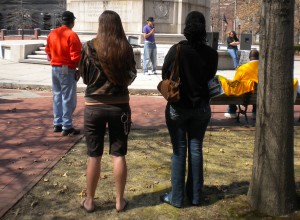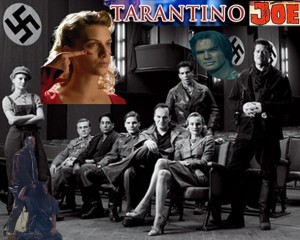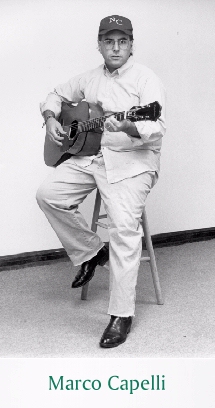If Tom Joad Isn’t an “Injun†He Sure Thinks Like One: Searching for Indigenous Thought In The Grapes of Wrath
Marc Frucht
“Steinbeck’s liberal mixture of native philosophy, [and] common-sense leftist politics, blue-collar radicalism, working-class characters, homespun folk wisdom, and digressive narrative form – all set to a bold, rhythmic style and nervy, raw dialogue – qualified the novel as the ‘American book’ he had set out to write.”
— Robert DeMott
Last April, San Diego State University held a moderated panel called, “Watching Steinbeck’s Ethnic Eye/I,†in celebration of American author John Steinbeck. They planned a “wide-ranging and electric overview from multiple perspectives of what happens to Ethnic Americans when they find themselves portrayed in the pages of John Steinbeck’s writings and in films based on the same.†They say the four full professors, a dean, and an associate professor would turn their own incisive critical eyes on “Mexicans,” “Chicanos,” “Italians,” “Italian-Americans,” “Chinese,” “Asian Americans,” and “Caucasians,” aka “White folk” as they figure in Steinbeck’s oeuvre. An important minority group has gone unrepresented here as the conference discusses everyone in Steinbeck’s world except First Nations people. This absence of Indigenous thought gives much cognitive dissonance when Robert DeMott’s scholarly introduction to the book is taken into consideration, for it has pointed out so clearly that Steinbeck used a great deal of native philosophy. It’s also worth noting that during this book’s publication the mythology of the “vanishing Indian†was still so strongly in effect that most indigenous people were considered either black, white or the last of their kind. They soon slip into other cultures where they appear to have vanished.
In this essay I argue that Steinbeck’s travelling character Tom is part American Indian and/or has a clear indigenous sensibility that shows throughout Steinbeck’s entire 1939 novel Grapes Of Wrath.
Tom survives the great Dust Bowl of the Dirty Thirties, and so do some of his kin, even though quite a few of the people he encounters in his travels don’t fare so well. This book could be a perfect metaphor illuminating just who is best equipped to survive natural disasters throughout history when many others simply are not. Can this be a handbook for how to survive desertification, ice ages, plagues and tsunamis? Indigenous people might recognize this Steinbeck book as just that kind of story. With current issues facing America and the world, we would be wise to heed this book’s numerous battle cries; and most urgently, rather than busying ourselves debating whether global warming is man-made or natural; we should consult people still alive here on Turtle Island whose ancestors remember exactly what they did to survive several ice ages and droughts.
I won’t push the assertion that Tom’s cigarette use is any kind of symbol for sacred tobacco carrying, but his dialogue might easily mark him as a youthful but wise elder. I will however, search through Steinbeck’s book for some of the many social cues that seem to signify him as a “first nations†American. For I believe Tom carries much indigenous culture along with him in his travels.
“I seen turtles all my life,†says Tom in Chapter 6. “They’re always going some place. They always seem to want to get there.†(44-45) It’s wrong to suggest a non-Indian can’t be observant of the natural world, but it is the Indian who is most known for being highly observant especially in personifying animals; for when others see only stone, wood or turtles, Indians see animacy with a reverential awe.
That both Tom and his father dislike the written word might be another clue. Oral tradition trumps written work in Indigenous culture. Many Indians who are good at writing still prefer the verbal; and most insist on confirming important events personally even when telephone or email could seem to facilitate more rapid communication.
The slang term ‘Injun’ appears 15 times in The Grapes Of Wrath. ‘Indian’ shows up seven times; with the expression ‘Native’ featured four times as well. Since Robert DeMott’s introduction to the Penguin edition refers to Steinbeck’s “liberal mixture of native philosophy,†the Ethnic Eye/I panelists must be oblivious to Steinbeck’s liberal mixture; or are they deliberately erasing Native Americans from yet another part of history through their lack of inclusion in this very literary theory panel discussion? In fairness to them, maybe they are unaware, yet fall right into this age old trap of seeing Native Americans only as relics and artifacts rather than living, breathing, thriving members of families travelling through places like Oklahoma and Missouri toward regions such as Arizona, California and Oregon.
So just how does Tom Joad interact with these ‘Injuns’ in the story? He seems to have the same kind of respect for them that he shows his own mother. Steinbeck seems to be using this expression “Injun†to show its use by the people rather than as a written pejorative. A velvet pillow has a “pitcher†of an Injun on it. Tom’s brother Al says Grampa took it because he’s got Injun blood. Or later we read, “maybe that Injun knowed somepin,†and, “His Injun blood smelled ‘em.†Seldom is it Tom using the word Injun. He tends to refer to American Indians by name, such as Jules; while other people like Willie will say “that Injun.†Now, Tom doesn’t correct, scold or condescend to people who have used the expression around him; he just uses different terminology himself. He shows rather than tells that this isn’t his way.
Johnathan Culler mentions in his book Literary Theory: A Very Short Introduction that the study of Minority Discourse is a crucial political change that academic institutions have achieved:
The main effort has been to revive and promote the study of black, Latino, Asian-American, and Native American writing. Debates bear on the relation between the strengthening of cultural identity of particular groups by linking it to a tradition of writing and the liberal goal of celebrating cultural diversity and ‘multiculturalism.’ (131)
So, Culler also says ‘minority discourse’ can be used as a tool making it easier to develop concepts for analyzing cultural traditions and exposing assumptions that ‘majority’ discourse lives by. This would work even better than Culler already suggests when we include oral tradition, ethnohistory and even Tom’s father who likes to talk instead of writing (because it gives him shivers.) For as Culler says, “narrative is not just an academic subject. There is a basic human drive to hear and tell stories.†(83)
I’ll mention that Princess Red Wing, the Indian girl in color pictured on the wall of the abandoned Joad family house was a gifted Narragansett storyteller and leader from Exeter, Rhode Island who used to dance in the Ziegfeld Follies and was close friends with Mohegan medicine woman Gladys Tantaquidgeon who had a history degree at University of Connecticut, not to mention honorary doctorates at UConn and Yale. Steinbeck is writing strategically here when he included Princess Red Wing. It is no accident that this “Indian girl in color†is a renowned museum curator and lecturer. This will sound surreal and post modern, but Steinbeck is telling a story about a storyteller (Tom) who meets the consciousness of another storyteller (Princess Red Wing) who just may be a clean parallel to the narrator of the book itself: the consciousness, or the land.
Is Tom Joad attuned to this vision? He seems to be, right from the earliest parts of the story when fresh out of prison Tom meets an over-the-road truck driver who seems to be similarly socialized. “Some sings an’ some whistles,†says the trucker. “Company won’t let us have no radio. A few takes a pint along, but them kind don’t stick long.†(10) Some of the other characters throughout this story share this alertness Tom and the trucker have; but let’s focus primarily on what Tom says and does.
After Tom skins a jackrabbit cleanly and quickly, Muley tells him he’d better look out for boils, but Tom points out he’s already searched it over and it’s clean so it’s ready for cooking and eating now. Someone who looks over the efficiency and cleanliness of a kill for food has a role in many cultures, whether s/he is a Rabbi or a Medicine Man (or perhaps in secular circles it’s just an executive chef at a restaurant) Every culture might have people who are more attentive to this than others. Tom, who seems to notice everything in the natural world around him, seldom misses any of this.
Handling of living animals might be worth looking at also; because another clue might be Tom naming the turtle he’s caught as a gift for his younger brother. He looks it over and calls it an old bulldozer. This reminds me of a higher level of nicknaming I learned while I was living on the Navajo reservation in Arizona. One morning a young boy named Harrison asked me to help him with midwifery because his grandmother tasked him to watch over a sheep who was giving birth. The wool on her head stuck straight up and was black, white, and gray which made her “hairstyle†look remarkably similar to that of the famous boxing manager Don King,. So Harrison and I agreed we should call her Don King from that moment on.
“What about Grampa,†Tom asks regularly, or “How’s Granma?†Some of his siblings and in-laws don’t ever seem too concerned about the elders but Tom seems to have feelings of reverence toward all old people. One use of the word “elder†in this story refers to the organic government of leaders and elders that evolved in the camps. Steinbeck seems to take that opportunity to discuss worlds where people with food feed anyone hungry to insure themselves against hunger, as well as other topics of water, cooking, nutrition and perhaps even culture.
The night that Tom spends at his abandoned boyhood home after returning from prison to find his family gone is significant as well. If he’s discovered there at any time he could be found guilty of trespassing in his own boyhood home – something quite similar to how contemporary American Indians must feel when visiting lands that their ancestors once controlled. Perhaps Steinbeck signifies here that Tom is similar to Indians in the Midwest; or he just might be implying that Tom IS Indian. It’s never written specifically, only implied in Grampa claiming he’s part “Injun†along with all these social cues.
Steinbeck juxtaposes large tractors against attempts to farm on a smaller scale the same way he enjoins travelling turtles to over-the-road tractor trailer trucks. This sets some interesting paradoxes into motion. The same large CAT or John Deere tractor bringing more goods to the market can destroy homes, families, and economies becoming the very force behind forcing prices down below sustainable thresholds. A turtle goes slowly but can live a very long time. He also has very short legs and walks close to the earth. Literary critic Peter Valenti says that “digging in the earth with fingers and toes establishes a connection with the land vital to human beings.†(Valenti,95)
In 1992 I learned anecdotally from a farming family in Indiana (oral history) that Native Americans and Amish families were the two groups getting the largest volume per acre for their corn in past decades and that they only use livestock, one-row tractors and their own hands. Their yields were higher than all of the Monsanto and Archer Daniels Midland concerns despite all of their high-tech 6-row harvesters, pesticides, antibiotics, and genetic modification. Valenti also says that Steinbeck and Aldo Leopold share a view that, “those who made the tools that disrupted the sensitive relationship between human society and land must turn their attention to restoring the balance.†(Valenti,110-111)
Critics generally accept the narrator of this book to be an anonymous, omniscient consciousness which sides with migrant and other working poor people. This serves an easy parallel to Mexico’s Virgin of Guadalupe; but since this book is clearly set above the Mexican border I’ll just argue that this narrator might be the land herself, or perhaps a pre-colonial vision that continues thriving on the land despite dustbowls, depressions, credit crises and growing police states. There are many other spots throughout the book where weather and landscape serve up some pathetic fallacy or even act as a character, but it might also be seen as a narration of sorts too. One such example has Ma sitting on the ground fanning flies away from her using a piece of cardboard to kick up some wind. The flies, the air itself and even the ground she’s sitting on could be saying “ghost town†without Tom or the author ever once specifying.
When Tom learns that his Uncle John (his father’s brother) had gone into Salisaw to sell belongings off, he seems rather matter of fact about it, instead of alarmed. He is more concerned that his sister who is married and expecting was forced to become an adult too early in life. Or maybe he’s just expressing his concerns about his sister’s welfare out loud so it stays on everyone’s mind when John returns with some money, for Uncle John is known to drink away cash now and then.
Perhaps a different essay should deal with Tom’s relationship with his mother, but suffice it to say he has inherited her strong sense of responsibility to family. When he’s away at prison he can’t do much for them of course; but when he’s present he does everything he can, and demonstratively so. Whether he’s helping his sister in and out of trucks, or sharing water, food, and good conversation Tom is mindful of keeping families together, even while migrating along Route 66.
Another paradox might be that the same forces driving families out of their homes empower women to take more control of their families’ own destiny as well as more control of their own welfare. There aren’t too many stories about women leaving their families like men do, when things get too difficult. They remain present, oftentimes heading up those families, not just for their children but any elders who are still alive, some of their own siblings and even a prodigal son like Tom who gets out of jail and returns to the family struggling to remain together while on the road. Many Native American families contain some very powerful matriarchs. When Ma swings around tire irons and skillets to “gain the floor†and speak authoritatively, what might seem out of character for a non-Indian family might be right at home for the Indigenous elder.
By struggling to keep her family together as one cohesive unit Ma is tending to all of rural America really. They lose everything else but they still have each other in this travelling family. Ma holds this family together even despite people dying as well as when some leave the fold while they’re in transit.
Essayist Nelly Y. Mckay shows Ma Joad as indestructible and at center stage. “At times,†McKay says, “she assumes mythic proportions, but her portraiture is also realistic and she acts with wisdom. Impressionistically she is firmly planted in the earth, but she is more dependable than the land, which could not withstand the buffeting of nature or the persistent demands of small farmers or the evil encroachment of technology and corporate power.†(McKay,57) McKay seems to be implying that Ma Joad is America, Turtle Island, or the family of man, but after looking over her somewhat environmentalist take on feminist theory I’m certain she is the land herself or Mother Earth as the expression goes.
So after the “Great Depression,†will Turtle Island survive past the 20th Century? Well if Tom can inherit his mom’s responsibility to family; and his sister Rose can selflessly feed people who aren’t even directly related to her when she doesn’t stand to gain much of anything in return besides knowing she’s saved a life, perhaps it will.
Works Cited
Culler, Johnathan. Literary Theory: A Very Short Introduction. NY: Oxford, 1997.
McKay, Nellie Y. New Essays on the Grapes Of Wrath. Ed. David Wyatt. Cambridge: Cambridge, 1990.
Nericcio, Bill. “Watching Steinbeck’s Ethnic Eye/I.” James Hervey Johnson
Charitable Trust. Celebration Of John Steinbeck. San Diego State
University, San Diego. 19 Apr. 2009.
Steinbeck, John. Grapes of Wrath. London: Penguin Books, 2006.
Valenti, Peter. Steinbeck and the Environment. Ed. Susan F. Beegel. Tuscaloosa: University of Alabama, 1997.








